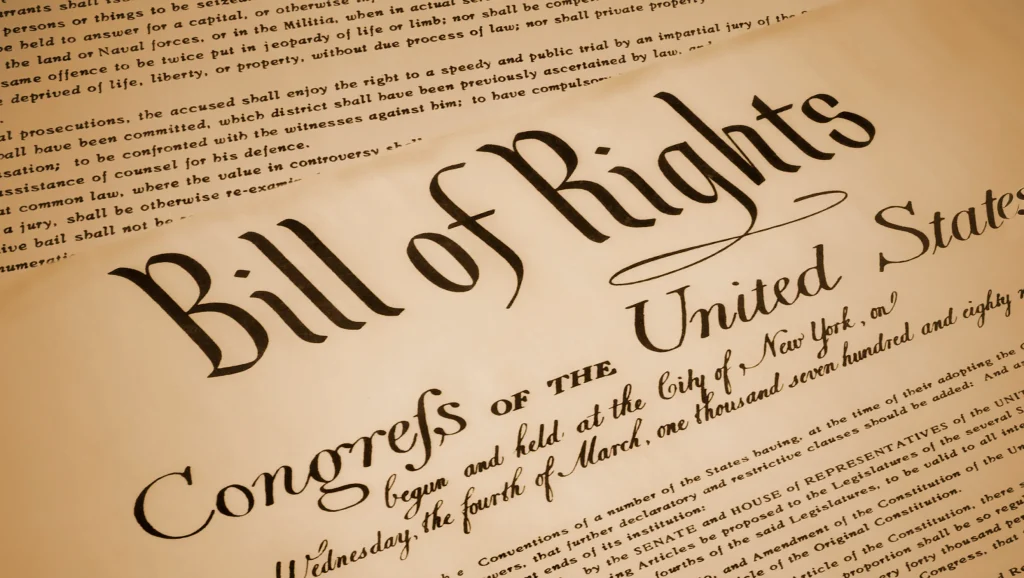
“No date in the long history of freedom means more to liberty-loving men in all liberty-loving countries than the 15th day of December 1791.” President Franklin Roosevelt, in a historic radio address in 1941, made that opening statement when he introduced a proclamation for the first Bill of Rights Day. Roosevelt also mentioned that there isn’t a country across the globe that hasn’t felt the effects of the “Bill of Rights”, directly or indirectly. In that speech he denounced Hitler and the Nazis in Germany, for taking away individual freedoms.
The proclamation by Roosevelt was issued to honor the 150th anniversary of the Constitution. The first Bill of Rights Day took place eight days after the bombing of Pearl Harbor and America’s entry into the Second World War.
World War II ended in 1945. One year later President Harry Truman issued another proclamation to observe Bill of Rights Day again. But it was not until 1952 that President Truman proclaimed Bill of Rights Day to be observed every year. The proclamation is usually paired with a proclamation on Human Rights Day and Week.
In 2019, President Donald Trump said about Bill of Rights Day, “During Human Rights Day, Bill of Rights Day, and Human Rights Week, we celebrate the Bill of Rights for safeguarding our God-given rights and protecting us from the abuse of government power.”… “I call upon the people of the United States to mark these observances with appropriate ceremonies and activities.”
The “Bill of Rights” was ratified on December 15, 1791. It is the foundation of the American system of government and the cornerstone of American democracy. Bill of Rights Day celebrates the day that the “Bill of Rights”, the first ten amendments to the Constitution, was ratified.
Those 10 amendments protect the most basic rights of Americans, regardless of nations, borders, race, sex, language, religion, or any other status. Those amendments consist of beliefs in freedom of speech, freedom of religion, freedom of the press, freedom from slavery and torture, the right to protest, the right to work, the right to education, equal protection under the law, and more. The “Bill of Rights” is the framework and the very basis of what should be granted to human beings.
Why was the Bill of Rights added to the Constitution?
There were two primary political beliefs when our system of government was developed. The Federalist advocated for a strong national government. They believed in a strong centralized government that promoted a national bank and heavy government subsidies. The Anti-Federalist believed the government would be too far away from the people and therefore be unresponsive to the needs of localities. They believed the Constitution would nullify, in part, the power of the states.
Madison, whose role in crafting the Constitution was crucial, is often referred to as the “Father of the Constitution.” On September 17, 1787, members of the Constitutional Convention signed the final draft of the Constitution. Because it did not contain any sort of Bill of Rights, an important issue to the Anti-Federalist, another convention was held to carefully review its content. Madison, as a member of the U.S. House of Representatives at the time, altered text where he thought appropriate. Several members of that Congress said he had no authority to change the wording. Madison’s changes, therefore, were presented as a list of amendments.
James Madison saw his changes, now called amendments, as a way to limit government power and protect individual liberties not protected by the Constitution. Madison’s amendments were strongly influenced by the Massachusetts Body of Liberties, the Virginia Declaration of Rights, and English documents such as the Magna Carta, the Petition of Right, and the English Bill of Rights.
The House approved 17 amendments. The Senate approved 12. A joint House and Senate Conference Committee settled the remaining disagreements. President Washington on October 2, 1789, sent copies of the 12 amendments adopted by the Congress to the states. By December 15, 1791, three-fourths of the states ratified 10 amendments, now know as the “Bill of Rights.” These amendments would follow Article VII of the Constitution. Article VII states that the Constitution shall become the official law.
The Bill Of Rights
Amendment 1 Freedoms, Petitions, Assembly
Amendment 2 Right to bear arms
Amendment 3 Quartering of soldiers
Amendment 4 Search and arrest
Amendment 5 Rights in criminal cases
Amendment 6 Right to a fair trial
Amendment 7 Rights in civil cases
Amendment 8 Bail, fines, punishment
Amendment 9 Rights retained by the People
Amendment 10 States’ rights
Bill of Rights Trivia:
The Bill of Rights toured the U.S. for 18 months from 1947 to 1949 on the Freedom Train.
The Bill of Rights was ratified on December 15, 1791 — however, Massachusetts, Connecticut, and Georgia waited until 1939 to ratify it.
James Madison originally incorporated the amendments into the text of the Constitution rather than adding them to the end.
The most recent, Amendment XXVII, was ratified on May 2, 1992. It was originally proposed on September 25, 1789, and was one of the two that was not passed in the original Bill of Rights. Amendment XXVII deals with compensation to members of the Senate and House of Representatives.
The Bill of Rights is displayed in The Rotunda of the National Archives Building in Washington, D.C., as a reminder to all Americans of their constitutional freedoms. It is a reminder of the freedoms we enjoy and the responsibilities we have to protect those freedoms.